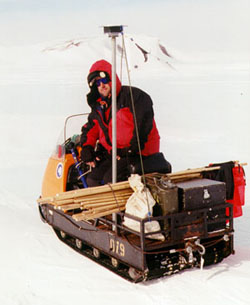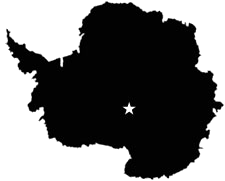


Upcoming ANSMET Field Season Update
Ralph Harvey
Several icefields in the Walcott Névé region are the major target of the 1999-2000 ANSMET season. This region, between the Beardmore and Law Glaciers, has produced numerous meteorites from the Lewis Cliff, MacAlpine Hills, and Queen Alexandra icefields. In addition to systematic searches of these areas, the team will conduct recon-naisance of the Geologists and Miller Ranges to discover whether they are suitable choices for future searches.

|
|
|
 |
Program News
|
New Meteorites
Marilyn Lindstrom
This newsletter contains classifications of 274 new meteorites from the 1997 and 1998 ANSMET collections. Descriptions are given for 9 meteorites; 3 eucrites, 2 aubrites, 2 carbonaceous chondrites and 2 unequilibrated or unusual ordinary chondrites. The most interesting are GRA98098, an unbrecciated eucrite with cross-cutting veins, and QUE97186, a CV3 chondrite. The two aubrites, while not particularly small (50 g each), are unfortunately quite weathered. More new meteorites from the 1998 collection will be described next newsletter, as well as numerous LL5 chondrites from the 1997 collection.
Smithsonian's Dept. of Mineral Sciences Relocate
Tim McCoy
In 2000, the Smithsonian's Dept. of Mineral Sciences will move into temporary quarters to allow renovation of the heating, ventilation and air conditioning systems in the department. We anticipate that the move out of our department will occur during Jan.-Feb., 2000, and the return move in Jan.-Feb., 2001. We will move the entire meteorite collection and the electron microprobe. Description of Antarctic meteorites should occur without noticeable disruption. During the time the collection is being physically moved between the department and our temporary quarters, no meteorites will be distributed from the Smithsonian collection. Any requests for meteorites which will be needed before March 31, 2000, including those for the Lunar and Planetary Science Conference, must be received by November 15, 1999. Any requests received after that date will likely not be filled until well into 2000.
New MWG Chair and Secretary
Marilyn Lindstrom
In March Ursula Marvin stepped down as MWG chair after two terms of superb leadership of the committee. Her association with the Antarctic Meteorite Program began with helping to establish the unique collaboration between three government agencies (NSF-NASA-SI) and included early service as a MWG committee member. She also participated in two ANSMET expeditions to collect meteorites. As MWG chair she deftly guided the committee through numerous debates and assisted NASA and NSF in the programs that responded to the announcement of possible fossil life in one of our martian meteorites. Her gentle but firm guidance will be missed. Meanwhile Greg Herzog has taken over as the new chairman whose experience and humor will lead us into the new millennium.
Further changes occurred as Faith Vilas recently resigned as MWG secretary and was replaced by Kimberly Cyr, a planetary scientist from the University of Arizona who studies water in the solar nebula. Please address all requests to the curator.
.
NIPR Collects 4100 Meteorites!
Our colleagues in the meteorite department at NIPR in Tokyo resumed Antarctic meteorite collection in a big way by recovering 4100 meteorites. The field party led by Hideyasu Kojima
left Japan late in 1997, wintered at Syowa Station in Antarctica, then collected meteorites beginning in October 1998. The team returned in spring of 1999. The 4100 meteorites were collected mostly from the Yamato Mountains, with another 21 from the Belgica Mountains. NIPR will return to Antarctica this fall for another extended expedition led by Dr. Naoya Imae.
Initial results of the collection were presented in June at the NIPR Symposium on Antarctic Meteorites at which the Smithsonian and NASA curators and the new MWG Chairman were guests of NIPR. Although the new meteorites are not yet available, watch for classifications and instructions on how to request meteorites in future issues of Meteorites News which is published by NIPR. Inquiries and requests for all Japanese Antarctic meteorites should be addressed to:
Dr. Hideyasu Kojima
National Institute of Polar Research
9-10 Kaga 1-chome, Itabashi-ku, Tokyo 173-8515, Japan
Ph (81) 03-3962-2938; FAX (81) 03-3962-5711


